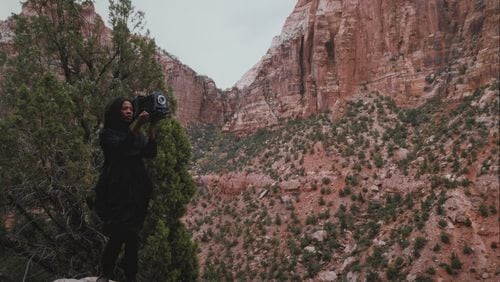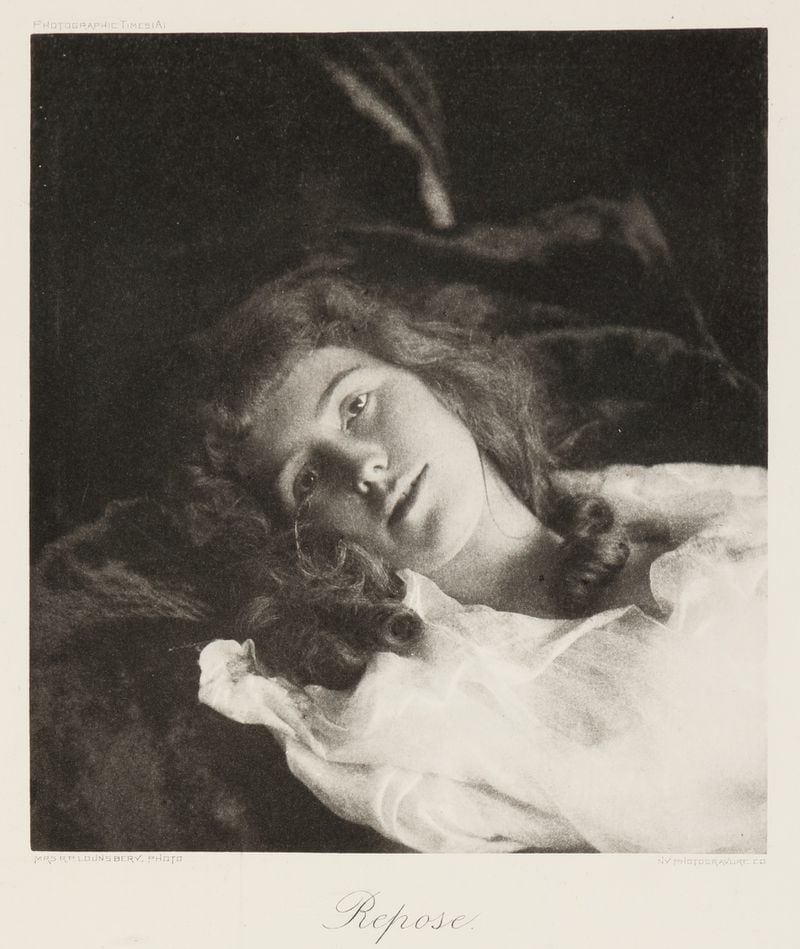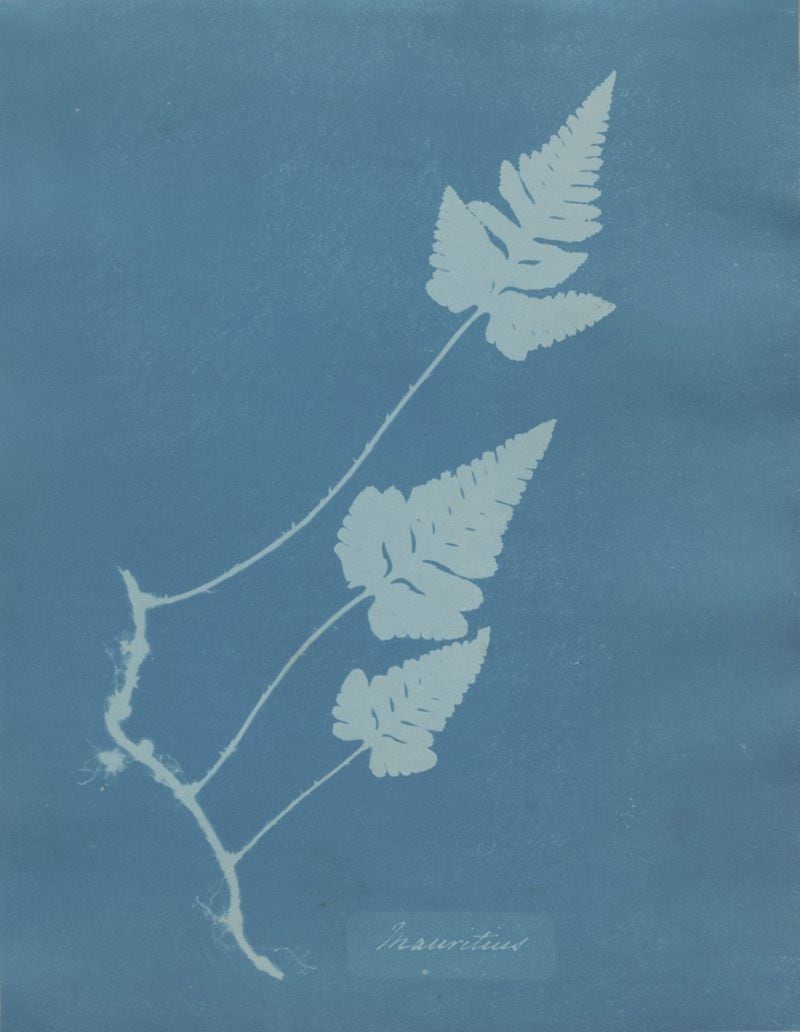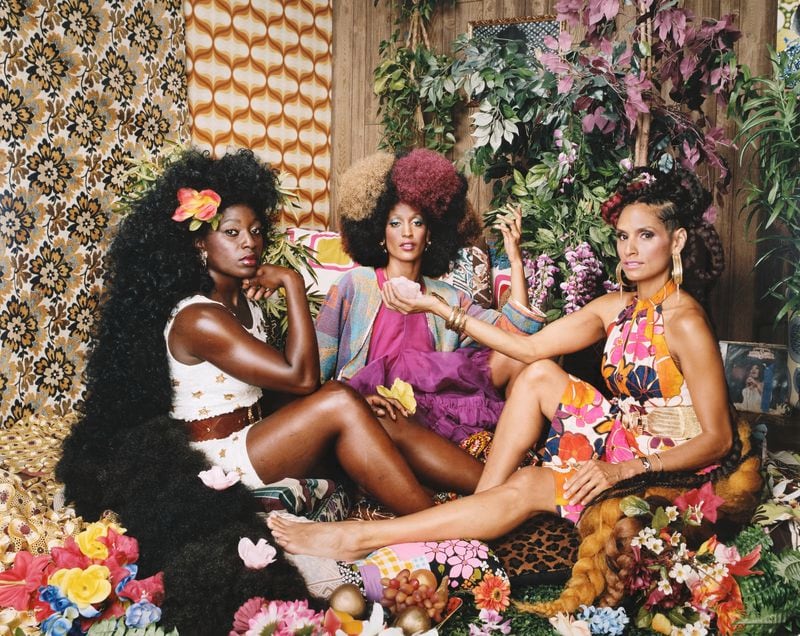As Sarah Kennel and Maria Kelly began selecting photographs out of at least 8,000 for the new High Museum of Art show, “Underexposed: Women Photographers from the Collection,” one was especially intriguing.
Taken in 1894 as photography became more accessible through the invention of film on a roll, the photo was a black and white portrait of a reclining woman. Long curled hair and a diaphanous white blouse light as cloud frame her face. Her lips are parted in the first stages of a smile. Her head rests against a tumble of lush, dark velvet. She seems at ease and, indeed, the photo is titled “Repose.”
The only problem was the photo was attributed to R.P. Lounsbery, a male photographer. Even so, Kelly wanted to use it, so she did some digging. After an extended Google search and a bit of research, Kelly figured out the photo had not been taken by American studio photographer R.P. Lounsbery, but instead by his wife, Edith H. DeLong, when she was 36 years old.
“It shows just how easily women can disappear from history,” said Kelly, co-curator of the show. “She was known for her work, so it was sometime later, whether it was a dealer or a curator, who didn’t know that and somehow (the photograph) got credited to her husband. It’s that slippage which is kind of interesting because she was renowned at the time and published, so recovering that history is nice.”
Credit: Edith H. DeLong
Credit: Edith H. DeLong
Giving credit where it’s due, correcting the record is but part of the energy behind “Underexposed,” which opened recently at the High. The exhibition runs through August 1.
The exhibition features 100 works by women, and at least one non-binary artist, whose work centers on women. Though arranged chronologically, the show isn’t a history of women in photography; rather it focuses on how the female gaze has evolved, and in some instances, remained constant over the past 100 to 150 years.
That legacy begins with British botanist and photographer Anna Atkins’ view of aquatic life. Captivated with both algae and the cyanotype process, in 1843 she created what is believed to be the first book with photographs.
From the pioneering work of Atkins in the early days of the medium, through the early 1900s,World War I and World War II, suffrage, the civil rights movement, and on through to the present, the way women view family, children work and themselves is told in each frame.
Credit: Anna Atkins
Credit: Anna Atkins
There are plenty of familiar names in the show. There’s the documentarian’s eye of Dorothea Lang and Diane Arbus’ insistence that no life be considered marginal. Nan Goldin, who chronicled LGBTQ life and the emerging HIV crisis of the 1980s, is represented. Carrie Mae Weems’ and Mickalene Thomas’ visions of Black womanhood, at turns stark and lush, are also featured. And Zanele Muholi, the South African photographer whose photographs celebrate transgender women and explores notions of gender, is an important part of the line-up.
Eleven of the more than 80 artists featured in the show are from Georgia including, Sheila Pree Bright, Lucinda Bunnen, Doris Derby, Nancy Floyd, Jill Frank, Myra Greene, Sarah Hobbs, V. Elizabeth Turk, Shelia Turner, Christina Price Washington and Angela West.
But for every very recognizable name, there are just as many artists unfamiliar to some viewers but who say something important about what it means to go through the world as a woman. Forty percent of the show is comprised of artists who have not been shown in the museum since 2000.
“One reason we wrote a little label for every person is we didn’t want people to feel like they looked at the picture and they didn’t know anything about it or about the maker and they were expected to come to it with some knowledge,” said Kennel photography curator for the museum.
Exposure can bring about popular familiarity, however, and that typically hasn’t been the case for women photographers. Kennel and Kelly said that in some ways it’s dubious that a show centered on women is even necessary in 2021. But numbers suggest it is.
As has long been the complaint in the art world, women have historically been underrepresented in museum collections. For example, 26% of individual artists in the High’s photography collection are women, but fewer than 26% of the number of works are by women, said Kennel. One artist might have as many as 500 images represented in the collection. Typically, those artists are men.
Work by male photographers has long held more privileged spots in both museum and individual collections.
“Gifts have been given to us, but it also reflects the ways that, at certain points in history, men have been able to have bigger careers and make more friends and sell more art, and so it becomes a kind of cycle,” said Kennel. “If you look at auction prices or market prices, male artists still tend to be the higher selling ones.”
That is changing, albeit slowly, said Kennel and Kelly. As women and people of color have become increasingly vocal on both social and mainstream media about the dearth of their work in museum holdings, some institutions are taking heed. Kennel said acquisitions for the High’s photography collection have skewed heavily toward women and people of color over the past two years.
Credit: Mickalene Thomas
Credit: Mickalene Thomas
This show was planned to coincide with the 19th Amendment centennial in 2020. The pandemic dashed those plans. But a woman was inaugurated as the first vice president of the United States this year. So perhaps a show centered on who women are, how they see themselves and the world around them, is right on time after all.
“Representation matters,” Kelly said. “The more representation you have, whether its race or gender, it’s important for people to be able to come into a space and see work that they can relate to, and work they hasn’t been able to be seen as much as it should have.”
About the Author





